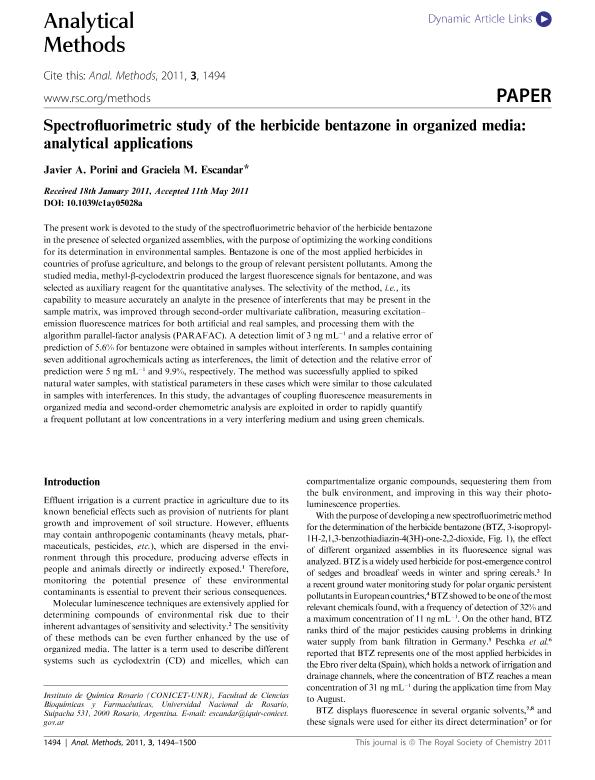Mostrar el registro sencillo del ítem
dc.contributor.author
Porini, Javier A.
dc.contributor.author
Escandar, Graciela Monica

dc.date.available
2021-03-08T12:15:42Z
dc.date.issued
2011-07
dc.identifier.citation
Porini, Javier A.; Escandar, Graciela Monica; Spectrofluorimetric study of the herbicide bentazone in organized media: Analytical applications; Royal Society of Chemistry; Analytical Methods; 3; 7; 7-2011; 1494-1500
dc.identifier.issn
1759-9660
dc.identifier.uri
http://hdl.handle.net/11336/127695
dc.description.abstract
The present work is devoted to the study of the spectrofluorimetric behavior of the herbicide bentazone in the presence of selected organized assemblies, with the purpose of optimizing the working conditions for its determination in environmental samples. Bentazone is one of the most applied herbicides in countries of profuse agriculture, and belongs to the group of relevant persistent pollutants. Among the studied media, methyl-b-cyclodextrin produced the largest fluorescence signals for bentazone, and was selected as auxiliary reagent for the quantitative analyses. The selectivity of the method, i.e., its capability to measure accurately an analyte in the presence of interferents that may be present in the sample matrix, was improved through second-order multivariate calibration, measuring excitation- emission fluorescence matrices for both artificial and real samples, and processing them with the algorithm parallel-factor analysis (PARAFAC). A detection limit of 3 ng mL-1 and a relative error of prediction of 5.6% for bentazone were obtained in samples without interferents. In samples containing seven additional agrochemicals acting as interferences, the limit of detection and the relative error of prediction were 5 ng Ml-1 and 9.9%, respectively. The method was successfully applied to spiked natural water samples, with statistical parameters in these cases which were similar to those calculated in samples with interferences. In this study, the advantages of coupling fluorescence measurements in organized media and second-order chemometric analysis are exploited in order to rapidly quantify a frequent pollutant at low concentrations in a very interfering medium and using green chemicals.
dc.format
application/pdf
dc.language.iso
eng
dc.publisher
Royal Society of Chemistry

dc.rights
info:eu-repo/semantics/openAccess
dc.rights.uri
https://creativecommons.org/licenses/by-nc-sa/2.5/ar/
dc.subject
HERBICIDES
dc.subject
BENTAZONA
dc.subject
ORGANIZED MEDIA
dc.subject
FLUORESCENCE
dc.subject.classification
Química Analítica

dc.subject.classification
Ciencias Químicas

dc.subject.classification
CIENCIAS NATURALES Y EXACTAS

dc.title
Spectrofluorimetric study of the herbicide bentazone in organized media: Analytical applications
dc.type
info:eu-repo/semantics/article
dc.type
info:ar-repo/semantics/artículo
dc.type
info:eu-repo/semantics/publishedVersion
dc.date.updated
2021-02-18T15:22:51Z
dc.identifier.eissn
1759-9679
dc.journal.volume
3
dc.journal.number
7
dc.journal.pagination
1494-1500
dc.journal.pais
Reino Unido

dc.journal.ciudad
Londres
dc.description.fil
Fil: Porini, Javier A.. Consejo Nacional de Investigaciones Científicas y Técnicas. Centro Científico Tecnológico Conicet - Rosario. Instituto de Química Rosario. Universidad Nacional de Rosario. Facultad de Ciencias Bioquímicas y Farmacéuticas. Instituto de Química Rosario; Argentina
dc.description.fil
Fil: Escandar, Graciela Monica. Consejo Nacional de Investigaciones Científicas y Técnicas. Centro Científico Tecnológico Conicet - Rosario. Instituto de Química Rosario. Universidad Nacional de Rosario. Facultad de Ciencias Bioquímicas y Farmacéuticas. Instituto de Química Rosario; Argentina
dc.journal.title
Analytical Methods
dc.relation.alternativeid
info:eu-repo/semantics/altIdentifier/url/https://pubs.rsc.org/en/content/articlelanding/2011/AY/C1AY05028A#!divAbstract
dc.relation.alternativeid
info:eu-repo/semantics/altIdentifier/doi/http://dx.doi.org/10.1039/C1AY05028A
Archivos asociados
